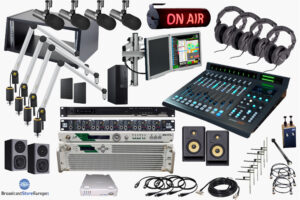Costs of Establishing an LPFM Radio Station in the United States

Creating a Low Power FM (LPFM) radio station is far from being a budget-friendly endeavor, especially in the United States. There are multiple crucial expenses that individuals aspiring to become broadcasters must carefully contemplate. From the procurement of equipment and infrastructure to handling legal matters and engineering tasks, as well as operational expenditures, having a comprehensive understanding of the financial demands is paramount for success. In this article, we’ll delve into the various costs associated with establishing an LPFM radio station, shedding light on the financial aspects that potential broadcasters in the United States should be well-versed in.
I. Engineering and Legal Expenses Engineering Study and Fees for FCC Technical Consultants:
As a mandatory step in the application process, an engineering study is essential to assess the technical viability of the proposed station. Engaging FCC Technical Consultants to conduct the necessary engineering studies involves expenses that may vary depending on the study’s complexity.
Legal and Administrative Costs:
Employing legal counsel to review documentation, offer compliance guidance, and ensure adherence to FCC regulations could become necessary. These legal and administrative expenses can fluctuate depending on the application’s complexity and the services required. In many cases, FCC Technical Consultants can adeptly address issues as they arise.
II. Studio Equipment and Setup Studio Equipment:
Establishing a professional-grade studio demands audio mixing consoles, microphones, headphones, monitors, computers, and recording/editing software. The cost of studio equipment can vary depending on the desired level of quality and functionality. For a basic studio setup, expect to allocate a minimum of $2,500.00.
Automation Systems:
LPFM radio stations often rely on automation systems for programming scheduling and management. These systems enable pre-recorded content, music libraries, and advertisement management. The cost of automation systems depends on the desired features and complexity. Additionally, there’s the option of integrating “audio processing” into your transmitter, but in most cases, it’s recommended to have it as a separate item for operational reliability. There are some automation systems available at no cost.
Emergency Alerting System (EAS) Equipment:
EAS equipment is a crucial component, and cutting corners in this area can lead to significant fines when inspected by the FCC. A prospective LPFM radio applicant should allocate at least $4,000.00 for a legally compliant EAS system, as it’s federally mandated and should not be overlooked.
Furniture and Acoustic Treatment:
Crafting a functional and comfortable studio space involves expenses related to furniture, acoustic treatment, soundproofing, and equipment racks. The cost varies depending on the specific design, making it a topic for discussion at a later stage.
III. Tower and Antenna Installation Transmission Equipment:
Investing in broadcast-quality transmitters, antennas, and related equipment constitutes a substantial expense for a Low Power FM radio station. The cost depends on factors like power output, coverage area, and signal quality. It’s important not to underestimate the importance of a high-quality transmitter. Cost will vary depending on your specific situation. This will range from $2000 to $4000.
Tower Construction or Lease:
LPFM radio stations require a tower for effective radio signal transmission. Broadcasters can choose to construct their own tower or lease space on an existing one. Costs fluctuate based on location, tower height, and necessary permits. This cost will vary depending on your particular location and needs.
Antenna Installation and Maintenance: Proper antenna installation is essential for signal propagation and coverage. Costs include acquiring the antenna or leasing tower space and the associated installation expenses. Ongoing maintenance and periodic inspections may be required, incurring additional costs.
IV. Operational Expenditures Staffing:
Operating the station necessitates personnel, including DJs, technicians, administrators, and support staff. Expenses encompass salaries, benefits, and potential recruitment or training costs. It’s common for LPFM radio stations to rely on volunteers, which introduces its own set of considerations.
Programming and Content:
Creating engaging and diverse programming might involve expenses like licensing fees for music, syndicated shows, or content development. This category may also include costs related to procuring news services, talk shows, or specialized content, which will be discussed in future articles. Typically music licensing for an LPFM radio station will run approximately $1,500 per year.
Utilities and Facilities:
Sustaining a Low Power FM radio station requires ongoing expenses for utilities like electricity, internet connectivity, and phone services. Furthermore, costs associated with office space or rental facilities, maintenance, and repairs should be factored into the budget.
With the aforementioned in mind you should budget at a minimum $10,000.00 to $16,000.00 to build the new station The good news is you will have three years to gather these funds, equipment and build the Low Power FM Radio station. So there is plenty of time to accomplish this before the construction permit expires. Once you have the construction permit in hand Nexus can assist you with a more precise cost assessment with specific equipment and details. Stay tuned for forthcoming articles designed to provide further insights into the costs and financial considerations associated with becoming a part of the broadcasting community.
